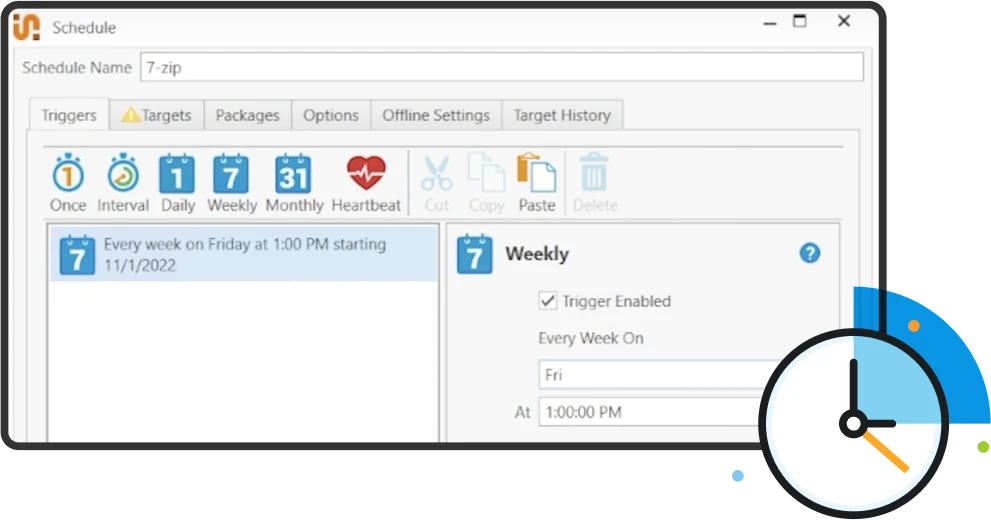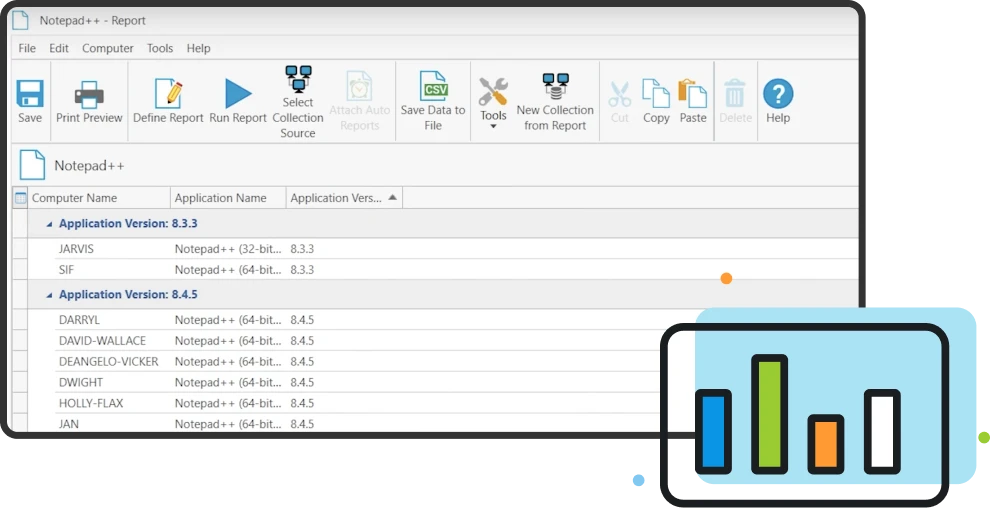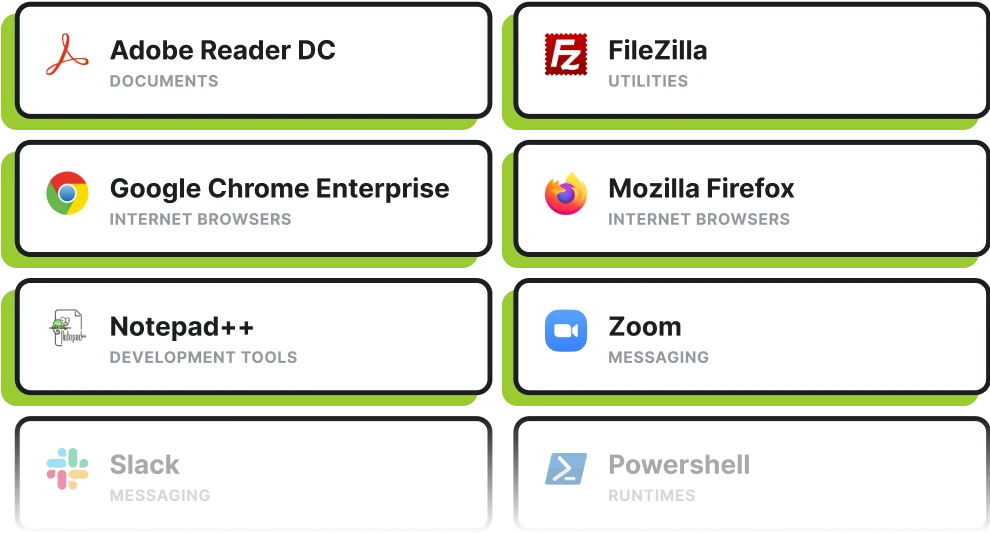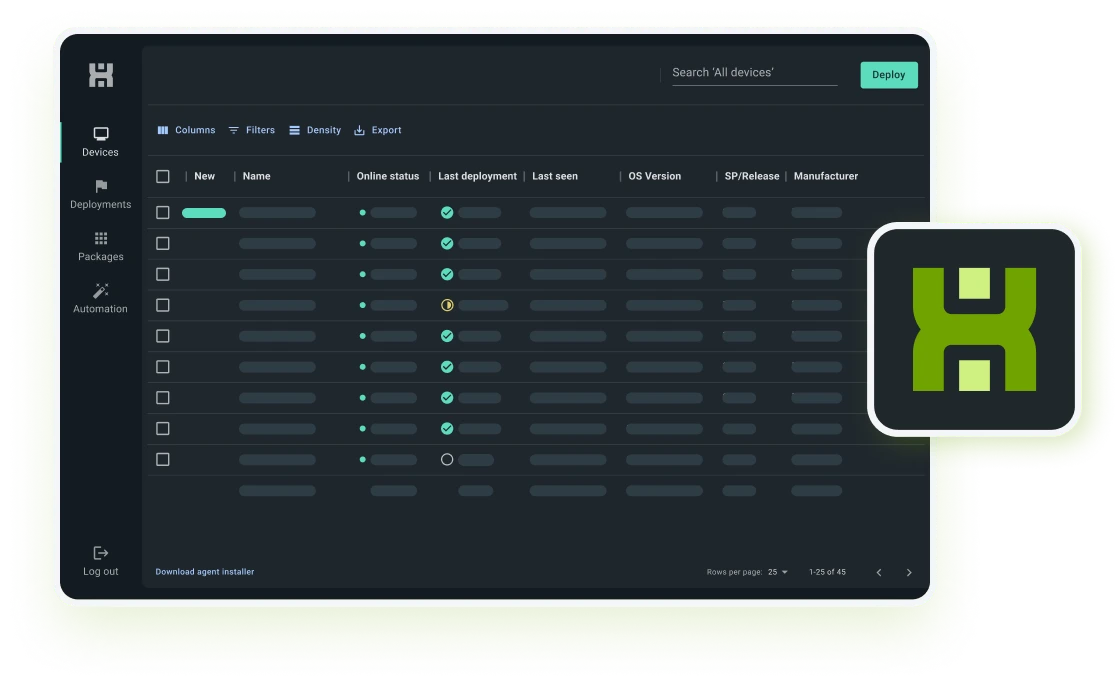Must-have patch management features
As a sysadmin, you want a Windows patch management solution that helps keep your systems secure and up to date while minimizing manual effort and maximizing efficiency. Here are four features you might look for in a patching solution, like PDQ.
Automation
The sysadmin life is hard. We have to take whatever easy wins we can. Use PDQ to automate the deployment of patches across any number of systems, reducing the time and effort required to keep systems up to date.


Automatic software deployment
Forget those late nights alone in the office. Schedule routine updates for off-hours so that they don’t interfere with your users’ workflow or your personal life.
Retry queue
Initiate deployments when an offline computer comes back online to target those hard-to-reach machines. Line up failed deployments and knock them down with automatic redeployment.
Reporting
Reports are critical to keeping your endpoints patched and your boss happy. That’s why PDQ provides detailed reporting and data on patch compliance and system health, allowing administrators to identify and address issues quickly.


Custom and prebuilt reports
Document information on each device, software solution, patch deployment, patch status, and more.
Status updates
In Deploy, set patch deployment notifications via email, Slack, or Microsoft Teams.
Data for audits
Gather information to audit your software and hardware, making the process significantly less nightmarish.
Prebuilt packages
Package libraries are instrumental in ensuring up-to-date patches are readily available to download and deploy, giving the busy sysadmin time back in their day.


Package Library
Silently install over ready-to-deploy applications. Patch Windows, Google Chrome, and other popular solutions with just a few clicks.
Custom packages
Build your own packages for unmatched flexibility.
Device collections & groups
Collections or groups allow you to target devices based on specific criteria, giving you more granular control.


Dynamic collections & groups
Use filters for operating system, OS version, installed application, and more to compile collections or groups that stay up to date automatically when inventory changes.
Static collections & groups
Populate collections or groups manually to target machines based on your own relevant criteria, such as department or location.
What are the benefits of patch management?
The main benefits of PDQ’s patch management software are improved security, performance, and efficiency. Between installing each Google Chrome, Microsoft Office, Windows Server, and Windows update, keeping your software current is time consuming. Add in more third-party applications, and it becomes exponentially more difficult.
Security patch management is particularly critical. When a known vulnerability is announced, hackers scramble to exploit it before businesses update their machines. Each uninstalled software patch presents an invaluable opportunity for cybercriminals.
But the upsides of PDQ’s patch management software go beyond thwarting hackers:
Improve security vulnerability management
Reduce endpoint security vulnerabilities
Maintain regulatory patch compliance
Enhance software performance
Save time for the IT security team
As an added bonus, proactive patch management tends to be easier and more affordable than disaster recovery.
Patch management for remote devices
Use our agent-based solution, PDQ Connect, to keep your fleet up to date and secure via the cloud. View real-time data, deploy software using custom or prebuilt packages, and automate IT tasks — from one platform to any internet-connected Windows device.


PDQ vs. leading patch management competitors
PDQ Deploy & Inventory's patch management software | PDQ Connect's patch management software | Leading competitors | |
|---|---|---|---|
Automated patch management features | |||
Agentless local deployment | |||
Agent-based remote deployment | |||
Extensive ready-to-deploy Package Library | |||
Custom script deployment | |||
Integrated patch & inventory management | |||
Easy setup and use | |||
Comprehensive knowledge base | |||
Support from sysadmins |
Patch management FAQs
What is patch management?
You already know that keeping your systems secure and up to date is crucial — and that's where patching with PDQ comes in. Patch management is the process of regularly identifying, testing, and deploying software updates and the latest patches to ensure that your systems run efficiently and are protected against potential vulnerabilities and threats. A great patch manager, like PDQ Deploy or Connect, does just that.
Effective patch management ...
Keeps systems current and secure.
Improves performance and stability.
Ensures compliance with regulations.
Simplifies endpoint management through automation.
Enhances security and vulnerability management.
What is a patch management process?
A patching process entails everything involved in handling updates, from monitoring available patches through verifying that they deployed correctly. Here are a few common steps in the patch management process:
Assess your security risk
Monitor patch releases
Prioritize to install any critical patch first
Test patches
Schedule patch deployment
Deploy patches
Verify and validate patches
Document the steps you took
What is automated patching?
Automated patch deployment distributes updates automatically based on set criteria. It’s one of the easiest ways to make sure a missing patch doesn’t allow cyber threats into your environment.
Incorporating automated patching streamlines your patch management process and lightens your manual workload.
What other functions are related to patch management?
Patching goes hand in hand with a wide array of other processes, including the following:
IT asset management
Vulnerability management
Change management
Compliance management
Configuration management
Unified endpoint management
Therefore, implementing PDQ can improve your workflows for these functions.
How do you incorporate patch management software?
A business can incorporate patch management through careful planning and adopting the right patch management software (might we suggest PDQ?). You should assess your needs and goals to implement measures that work for you. Since no two environments are identical, the software that works for another business may not be ideal for you. Consider the following criteria:
Cybersecurity and patching needs
Acceptable risks
Asset management approaches
Processes for testing patch updates before widespread distribution
Patch deployment timeframes
Policies for handling uncommon situations (e.g., distributing out-of-band patches)
While each environment is unique, virtually all businesses aim to install missing patches quickly while minimizing interruptions for users. Focusing on achieving these goals within your constraints can help you get the most out of your patch management.
What are patch management best practices?
Patch management best practices can help you avoid delays and keep your environment secure. Here are some of the best practices for optimizing your patch management software usage:
Implement a centralized patch management system
Establish a patch management policy
Inventory your systems
Test patches
Maintain a software update schedule
Mark your calendar for Patch Tuesday when Windows patches are typically released
Use a high-quality software patch management solution
Implementing patch management best practices and PDQ in your environment can enhance your efficiency and effectiveness.
How do you choose the right patch management software?
Selecting the best patch management solution for your business can save time, secure your environment, and make life easier for your IT team. To choose the best patch management tool for your business, consider these factors:
Functionality
Ease of use
Supported systems and third-party applications
Reporting options
Available support
Once you’ve narrowed down your patch management software options, schedule demos to see the solutions you’re considering in action. Demos are a quick and easy way to explore the features, assess the ease of use, and ask any lingering questions. And if you’re demoing PDQ, our reps are also pretty darn fun to talk to once they’re fully caffeinated.
How do you patch remote devices?
Two types of solutions allow sysadmins to patch remote devices: agent-based and agentless.
Agent-based solutions: Once an agent is installed on the target device, an agent-based solution allows remote monitoring, inventorying, patching, and deployment from the cloud whenever the machine is connected to the internet. PDQ Connect is an agent-based solution.
Agentless solutions: To patch remote devices through an agentless solution, the machine must connect to your VPN. If you have readily compliant users, this option can be quick, easy, and convenient. Otherwise, prepare to dedicate time to begging users to log in to your VPN. PDQ Deploy & Inventory use an agentless approach.


